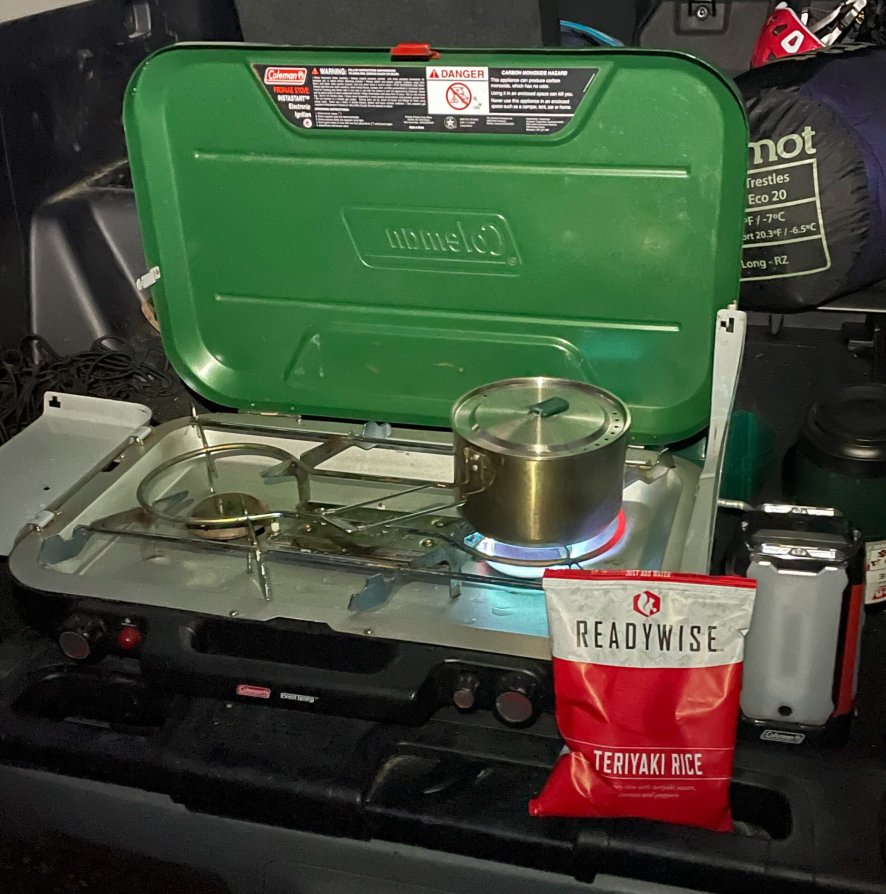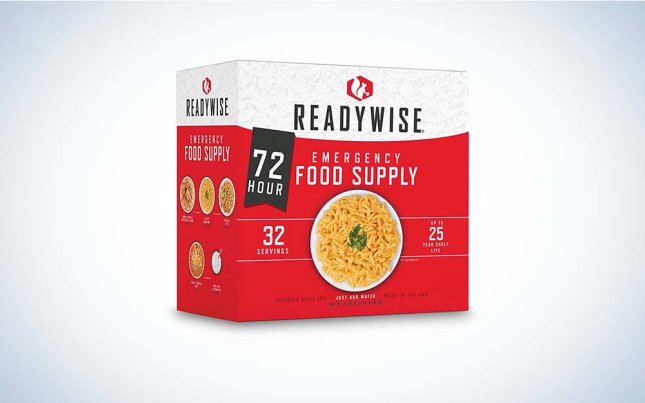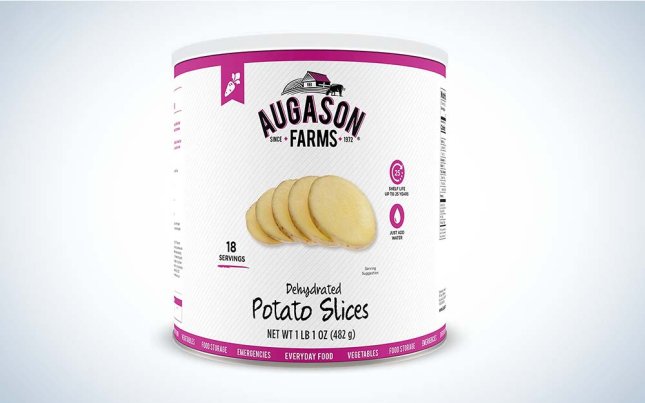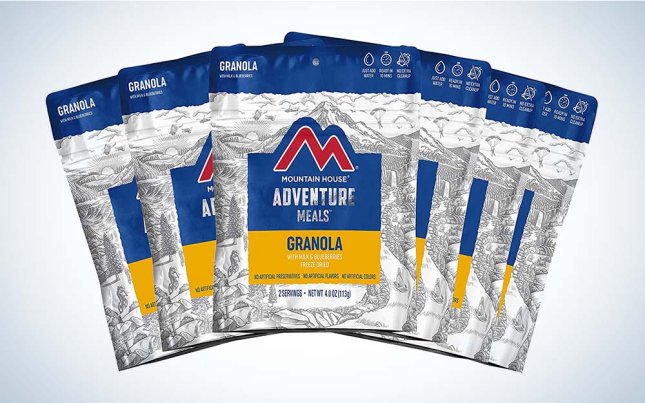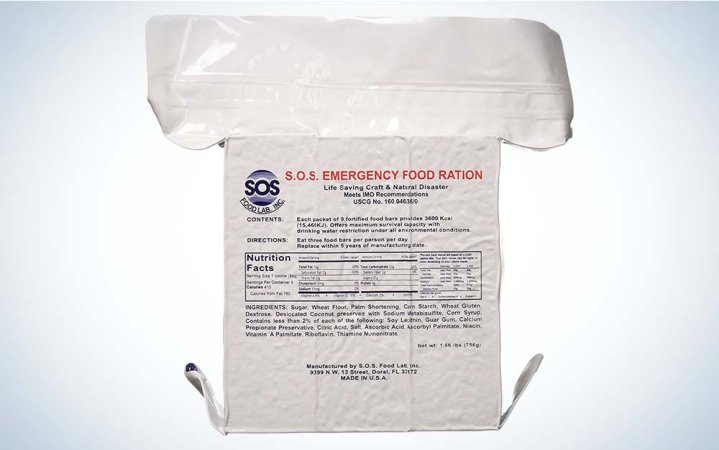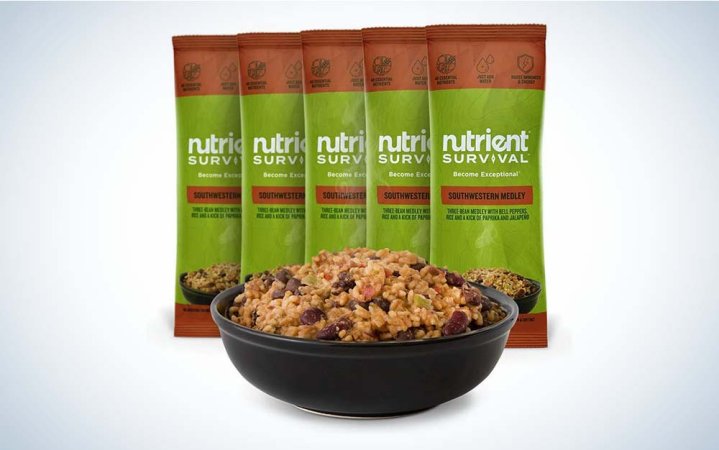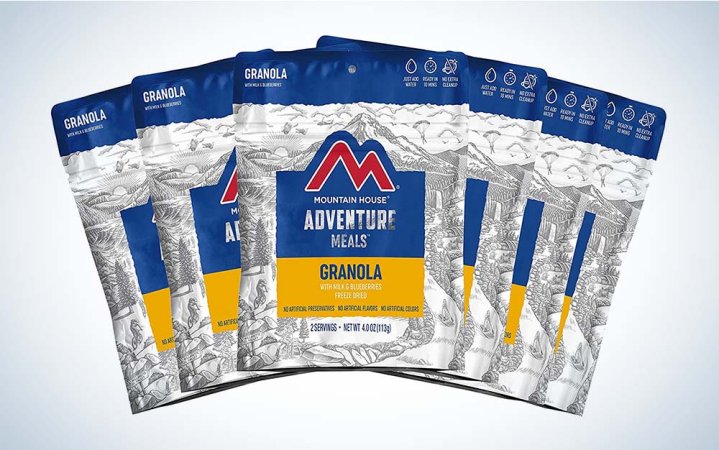We may earn revenue from the products available on this page and participate in affiliate programs. Learn More ›
Survival food isn’t something anyone particularly wants to eat on a regular day, but if you ever need to, this guide will help you make the best choice. Along with your basic non-perishable pantry foods, there are some must-haves you should add to your survival food shopping list (that aren’t MREs) to help you be ready for anything.
Regardless of your reasons for stocking up on emergency survival food, it’s important that your rations last as long as you need them to—without sacrificing too much taste in the process. Here are my picks for the best survival food on the market.
- Best All-Around Survival Food Kit: ReadyWise Emergency Food Supply 72 Hour
- Best Survival Food Bars: SOS Food Labs 3600 Calorie Emergency Food Bar
- Best Dehydrated Food Item: Augason Farms Dehydrated Potato Slices
- Best Pocket-Sized Survival Meals: Nutrient Survival Southwestern Medley Singles
- Best Survival Breakfast: Mountain House Granola with Milk & Blueberries
How I Tested the Best Survival Food
There’s a wide range of potential emergencies to prepare for, so I’ve gathered a list of prepper foods to apply to a variety of survival situations. I evaluated these survival foods based on the following criteria:
Objective measurements
- Calorie count and nutrient density
- Shelf life
- Preparation time/water required
Subjective opinions
- Taste
- Variety of meals/flavor options
Additionally, all of the survival foods on this list passed my “fullness” test, meaning they kept me completely full until my next mealtime, or approximately six hours. It was important to me that I felt I could sustain energy during my daily life on these meals, not just enjoy trying them.
Best Survival Food: Reviews & Recommendations
Best All-Around Survival Food Kit: ReadyWise Emergency Food Supply 72 Hour
Key Features
- Shelf Life: 25 years
- Packaging: Four servings per food package, 12 per powdered milk package
- Preparation: Add food into boiling water (approximately 17-minute total cooking time)
Pros
- Tastes great
- Well-rounded meal variety
- 25 year shelf life
Cons
- Multiple servings per sealed package (difficult to measure a single serving)
This best all-around survival food kit contains eight servings of brown sugar and maple multigrain oatmeal, 12 servings of whey milk alternative, and four servings each of cheesy macaroni, teriyaki rice, and hearty tortilla soup. The instructions on the back of each pouch are for preparing the whole thing at once, so it’s great for groups, families, or one large individual meal.
What sets ReadyWise apart from its survival food competitors is that it truly tastes like real food. Each serving of oatmeal, macaroni, and rice contains an average of 260 calories, 6g of protein, and 20 percent of your daily carbohydrates.
If you’re ever in the position to need survival food, it is likely very comforting to eat a hot meal that you could’ve cooked in a normal situation. I, for one, will be ordering this again to take camping because it’s easy to cook and share. If you are thinking about — or already are — compiling survival resources, ReadyWise should definitely be on your shelf.
Best Survival Food Bars: SOS Food Labs 3600 Calorie Emergency Food Bar (Coconut)
Key Features
- Shelf Life: U.S. Coast Guard approved for 5-year shelf life
- Serving Size: 410 calories per bar, nine bars per package
- Preparation: Just unwrap and eat
Pros
- High, dense calorie count
- 5-year shelf life
- Individually-wrapped
- Sweeter than other survival food
Cons
- High in sugar
- Very grainy, hard to eat the whole bar without water
These very dense and heavy survival food bars come in vacuum-sealed packaging. Each SOS Food Labs Emergency Food Bar is individually wrapped, so you can open one serving at a time, and you can store your bars individually across your bags, car, and home. They are coconut flavored with a cookie-like texture, and have enough density to keep you going throughout the day. These bars, however, do not have the same nutrient density as some meals on this list, so I recommend you keep them as high-calorie snacks, rather than a meal replacement.
There are survival foods out there with more calories, less sugar, and more vitamins, sure, but who doesn’t love dessert? Or, at least, some high-calorie semblance of dessert in an emergency situation. Don’t try to survive on just these bars, but you should keep each of the nine bars in a pack tucked away in various places, and you’ll worry a little less about when you’ll need one.
Best Dehydrated Food Item: Augason Farms Dehydrated Potato Slices
Key Features
- Shelf Life: 25 years unopened, one year after opening
- Can Size: 1 pound, 1 ounce of dried potato
- Preparation: Pour warm water over potatoes, cover for 15-30mins
Pros
- Great for cooking with or adding to meals
- Only hot water needed to prepare
- Potatoes are versatile and nutritious
Cons
- A lot of the potato slices were broken and crumbling upon opening
- The slides are peeled (a lot of nutrients come from the skin)
Augason Farms prepare a wide variety of freeze-dried vegetables and survival food kits. Their potatoes stand out as a versatile and tasty snack or meal ingredient. They’re a good source of energy, and there are many ways you can prepare them. One can of these dehydrated potatoes contains 18 servings, with easy recipes on the back that are easy to modify depending on what food you have available. And with a shelf life of 25 years (and of one year after they’re opened), these potatoes will never go to waste.
It’s nice to have ingredients in your emergency food stockpile, rather than just prepared meals. Bring Augason Farms’ dehydrated onions, carrots, and chicken into the mix, and you have a nutrient-rich meal full of vegetables and protein. Emergency situations don’t always mean you have to sacrifice variety (or your culinary integrity).
Best Pocket-Sized Meals: Nutrient Survival Southwestern Medley Singles
Key Features
- Shelf Life: 15 years
- Serving Size: One serving per packet
- Preparation: ½ cup of boiling water
Pros
- Easy to make and carry
- Full of nutrients
- Lightweight
Cons
- Food is dense to eat for just 280 calories
- Needs to cook for longer than 3-5 minutes for beans to be softer
Nutrient Survival loads each packet of Southwestern Medley with 14 vitamins, 13 minerals, 9 amino acids with 12 g of protein, 346mg of Omega 3, 789mg of Omega 6, and 6g of fiber. That’s a lot of nutritional benefit for only needing to add ½ cup of water for 3-5 minutes (although you should let it sit for slightly longer). The meal itself is vegetarian, tastes good, and has enough jalapeno and paprika to stay interesting.
For only slightly more effort and resources than a survival bar, this compact pouch will give you everything you need in a survival meal. While Nutrient Survival sells 10-serving cans of their survival foods, I think there is a benefit to being able to carry or store these tiny packages anywhere.
Best Survival Breakfast: Mountain House Granola with Milk & Blueberries
Key Features
- Shelf Life: 30 years
- Serving Size: Two 255 servings per packet
- Preparation: ¼ cup of water
Pros
- Easy to prepare
- 510 calories per bag keeps you full
- Long shelf life with great taste
Cons
- Pricier alternative to instant oats
- High in sugar
This bag of granola, powdered milk, and freeze-dried fruit is made with no preservatives. While the bag instructs you to add ¼ cup of cold water, I also tried adding hot water to mimic an oatmeal over a cereal. For how good this meal tastes and keeps you full, its 30-year shelf life is an added bonus.
Mountain House has made an objectively good breakfast food, and it is a solid addition to a strong survival food stockpile. Along with the two-serving pouches, I’d recommend ordering two 20-serving cans, one for camping, and one to be there for 30 years if you need it.
Things to Consider Before Buying Survival Food
The first thing to consider before buying survival food is what you’re anticipating having to survive. Do you expect a food shortage? Where you live, what kind of storage space you have, and why you’re buying food with a long shelf life are all things you need to consider.
Your intention could be having enough meals to go two weeks without leaving your house, or you could be anticipating a natural disaster. When you start to consider curating emergency essentials, do your research and make a list of what you can see yourself needing given any emergency situation (before you start shopping).
Read Next: The 10 Best Winter Survival Tips
FAQs
Short answer, don’t try. We need 20 amino acids to survive, as well as a variety of vitamins and minerals. But there are some single survival foods, like potatoes, that will get you by for longer than others in a survival situation. So, to avoid needing to ask this question, check your supply of emergency food, and be honest about how much variety you have. Your body and taste buds will thank you if you make an effort to mix things up.
While shelf life ultimately depends on the environment/temperature, storage, and whether your food’s seal is broken, yes, food can last for 25 years. In fact, most of the products I highlighted have an estimated shelf life of 25 or more years.
There are many things you can do now to prepare for being in an emergency situation away from a water source, or in one where you have lost running water. Storing multiple sealed jugs of water with your emergency food and stocking up on water purification tablets are great ways to start. Another source of emergency water could be these emergency drinking water packets. When it comes to both drinking and cooking water, you can never over prepare.
Final Thoughts
Outdoor Life editors don’t just enjoy hunting and fishing as hobbies—the pursuit of these passions make us who we are. Our writers are diehard outdoorsmen and women, too. For more than a century, OL has been evaluating the latest and greatest outdoor gear and providing our readers with no-B.S. reviews. We test products in the field under real-world conditions. We write about the pros and cons of every product we review so that you know exactly what you’re getting if you decide to purchase the gear we cover. Only the best hunting, fishing, backpacking, camping, and survival gear will make the cut in our reviews and roundups. If we’re covering it, you know it’s legit.
- Best All-Around Survival Food Kit: ReadyWise Emergency Food Supply 72 Hour
- Best Survival Food Bars: SOS Food Labs 3600 Calorie Emergency Food Bar
- Best Dehydrated Food Item: Augason Farms Dehydrated Potato Slices
- Best Pocket-Sized Survival Meals: Nutrient Survival Southwestern Medley Singles
- Best Survival Breakfast: Mountain House Granola with Milk & Blueberries
